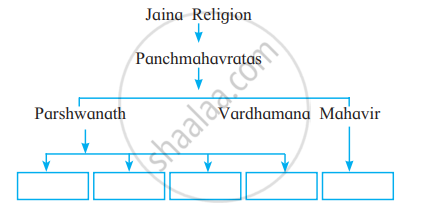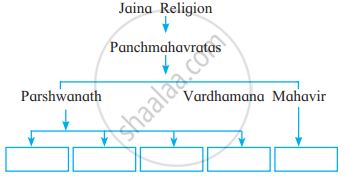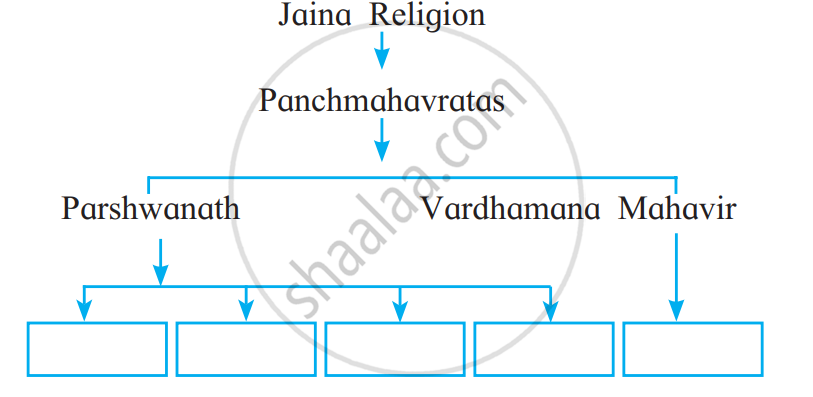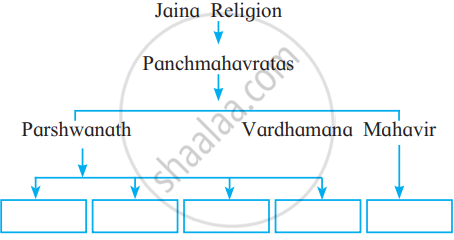Topics
First Farmers
First Cities of India
Chalcolithic Villages in India
Vedic Period
Janapadas and Republics
Second Urbanisation in India
India and Iran (Persia)
India During Mauryan Period
Post Mauryan India
Changing Times
Kingdoms in South India
India, Nations in the Northwest of the Indian Subcontinent and China
India, Sri Lanka and Southeast Asia
Delhi Sultanate, Vijayanagar and Bahamani Kingdom
India During Mughal Period
Swarajya to Empire (Maratha Period)
- Swarajya to Empire - Contribution of Sants
- Foundation and Expansion of Swarajya
- Maratha War of Independence
- Administrative System Established by Chhatrapati Shivaji Maharaj
- Release of Shahu Maharaj
- Peshwa Period
- Swarajya to Empire - Art, Architecture, Literature
- Swarajya to Empire - Trade, Industries, and Social Life
Notes
New Religious Trends:
A. Jainism:
The Jaina religion has a tradition going back to very ancient times. According to the tradition of Jain religion, Vardhamana Mahavira was the 24th and the last ‘tirthankara’ (saviour and the spiritual teacher). Parshvanath was the 23rd tirthankara. He gave four vows of nonviolence (Ahimsa), truth (Satya), nonstealing (Asteya) and non-possesion (Aprigrah) to his followers. Vardhamana Mahavira added the fifth vow of celibacy (Brahmacharya) to it. These five vows are known as ‘Panchmahavratas. Siddhartha, the father of Vardhamana Mahavira, was the chief of the ‘Dnyatruka’ clan. His mother, Trishaladevi was from the Lichchhavi clan. Vardhamana Mahavira was born in 599 B.C.E., in Kundgram near Vaishali. His wife’s name was Yashoda. Vardhamana Mahavira left home at the age of 30, in search of the truth. At the age of 42 he attained absolute knowledge (Keval Dnyana). Thereafter, people started addressing him as ‘Kevali’, ‘Jina’ and ‘Mahavira’. His followers came to be known as ‘Jaina’. Vardhamana Mahavira travelled and preached continuously for 30 years after the attainment of absolute knowledge. Vardhamana Mahavira addressed people in Ardhamagadhi, the language of common people. He preached about good behaviour and life of devotion (devotion to the five vows). He put absolute emphasis on the three principles of ‘Samyk Darshana’, ‘Samyk Dnyana’ and ‘Samyak Charitra’. These three principles are known as the ‘Triratna’ of the Jaina religion. They are the primary guiding principles for a person aspiring for the attainment of absolute knowledge. Vardhamana Mahavira preached that all beings, animate and inanimate, possess consciousness, to a varying degree. If hurt, each of them experiences pain.
The core principle of Vardhamana Mahavira’s philosophy is ‘pluralism’ (Anekantavada) or ‘many-sidedness’ of the truth. According to it, the truth has multiple facets. Mahavira founded the Jaina Sangha. Emperor Chandragupta Maurya was a contemporary of Bhadrabahu, the sixth principle Acharya of the Jaina Sangha. According to the Jaina tradition, Chandragupta Maurya had embraced Jaina religion.
B. Buddhism :
Gautama Buddha and Vardhamana Mahavira were contemporaries. Gautama Buddha was born in 563 B.C.E., in Lumbini (Rummindei) in Nepal. His father’s name was Shuddhodana. He was a member of the Shakya clan. Gautama Buddha’s mother’s name was Mayadevi. She was from the Koliya clan. Gautama Budhha’s wife was Yashodhara. Gautama Buddha left home at the age of 29, in search of the truth. This event is known in the Buddhist tradition as ‘Mahabhinishkramana’. Thereafter, Gautama Buddha tried to attain the ultimate knowledge through various means, such as seeking guidance from various gurus and extreme austerities. After realising that nothing of it was useful, he sat down meditating at Gaya, under a pippal (ficus religiosa) tree, on the banks of the river Niranjana (Lilajana). Here he attained enlightenment at the age of 35. After that, he was known as ‘Buddha’, ‘Tathagata’ and also as ‘Shakyamuni’. After the enlightenment, he delivered his first sermon in the deer-park at Ishipattana, near Saranath. This event is known as ‘Dhammachakkapabattan’. For the next 45 years, Gautama Buddha travelled continuously to preach dhamma to people. He taught in Pali, a language of common people.
In his sermons, Gautama Buddha addressed the fundamental question of ‘sorrow’ in human life. The root cause of human sorrow and the way to overcome it were two main issues addressed by Gautama Buddha. Gautama Buddha preached four ‘Aryasatyas’ (four great truths).
- There is Sorrow (Dukkha) everywhere in the world.
- The root cause of sorrow is Greed (Trishna).
- To conquer this greed is the way to cut the sorrow at its very root (Dukkhanirodha).
- The way to stop sorrow from emerging is the eightfold path (Ashtangika Marga).
Gautama Buddha explained the eightfold path by including:
- Samyak Drishti (To understand and accept that nothing happens against the rules of nature)
- Samyak Sankalp (Right determination)
- Samyak Vacha (Right speech)
- Samyak Karmanta (Right behaviour)
- Samyak Aajiva (Livelihood by right means)
- Samyak Vyayam (Conscious avoidance of offensive things)
- Samyak Smriti (Watchfulness and memory of right things)
- Samyak Samadhi (Establishing the mind firmly in equanimity; a state beyond pleasure and sorrow)
The eightfold path is also known as ‘Madhyama Pratipada’. Gautama Buddha founded the ‘Bhikkhu Sangha’. The concept of ‘Surrendering to Buddha, Dhamma and Sangha are very important. This concept is known as ‘Trisaran’. The three vows, namely, ‘Buddham saranam gachchhami’, ‘Dhammam saranam gachchhami’ and ‘Sangham saranam gachchhami’ are essential in the Buddhist religion. The 6th century B.C.E. saw a transition in all the fields of life, in ancient India. The power conflict among the mahajanapadas started in this century. It continued among the four mahajanapadas of Kashi, Kosala, Avanti and Magadha. By the 4th century B.C.E. the kingdom of Magadha grew powerful and the independent existence of the other mahajanapadas came to an end.
Text
Facts related to current affairs:
Today there are some six million Jains worldwide, and they represent less than 2% of India's population. The Jain community in India is centred in Rajasthan and Gujarat. Many migrated to East Africa and from there to Britain, where the community is around 30,000.
Svetambara Jain temples have been built in London, Leicester, and recently at Potters Bar, the latter being the largest purpose-built Jain temple outside India. As well as the Svetambara temples a new Digambara temple has just opened near London.
According to the National Family and Health Survey (NFHS-4) conducted in 2015–16, Jains form the wealthiest community in India.Jains have the highest literacy rate (87%) in India, in the 7-years to oldest age group, according to its 2011 census, and the most college graduates.Excluding the retired, Jain literacy in India exceeded 97%
Buddhism is a religion that is practiced worldwide. In fact, it is believed that as many as 535 million people around the world practice this religion, which would represent between 8% and 10% of the world's total population. There are several countries that have a very high proportion of Buddhism followers. It represents 7% to 8% of the world's total population.






